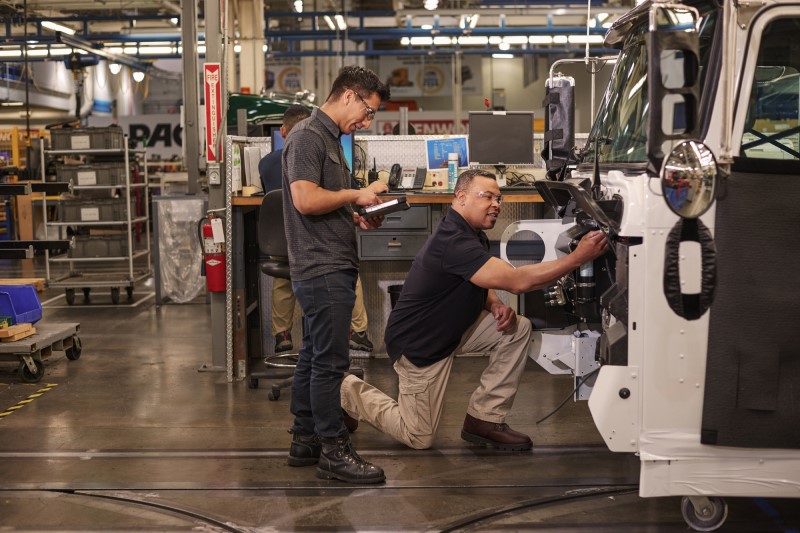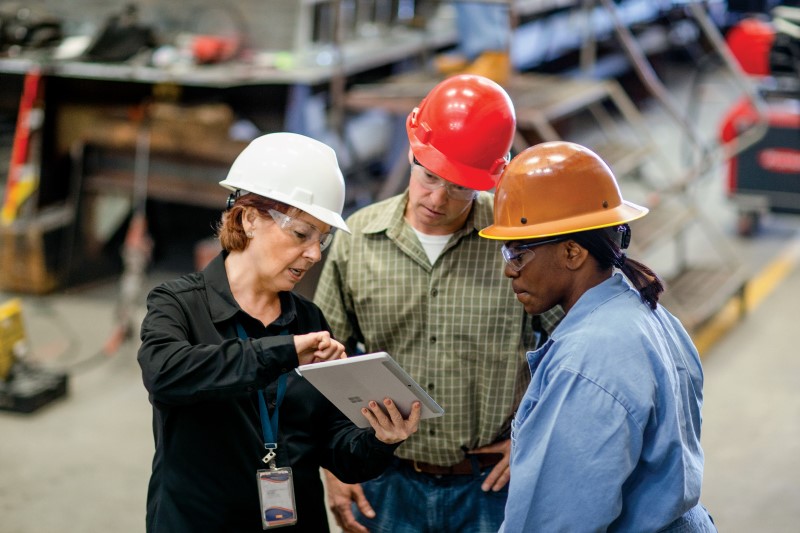
A new era of industrial transformation: 3 conversations to challenge your perspective
Manufacturing is at another defining moment. Supply chain disruptions, evolving regulatory requirements, and labor shortages have industry leaders once again prioritizing transformation initiatives. However, unlike past revolutions, manufacturers from industrial equipment to consumer goods need to do more than just make their physical processes more efficient. In this rapidly evolving market, they must go further by incorporating modern technologies, adopting sustainable practices, and enhancing supply chain resilience to meet complex demands.
There’s much to explore on this topic—that is why we developed A New Era of Industrial Transformation. This series, featuring analysts from Forrester, digs into the changing face of manufacturing, examining the related trends, use cases, and technology leading the way.
A New Era of Industrial Transformation
Discover how technology is helping overcome modern manufacturing challenges

Episode 1: Converging technology and its combinatorial effect
In the first conversation, Dominik Wee, Corporate Vice President of Manufacturing and Mobility at Microsoft, sits down with guest Paul Miller, Vice President Principal Analyst at Forrester, to discuss how manufacturing organizations are using technology to improve their operations. Acknowledging the challenges that manufacturers face today, Paul reviews some findings of our commissioned research conducted by Forrester Consulting, Accelerate Future Manufacturing Transformation. Focused on the industrial metaverse, the research examines why organizations are turning to this emerging category to integrate their physical and digital environments to find balance.
Industrial metaverse: The data driven future of industries
Read the blogWhile new, this confluence of technology is already providing value. Forrester sees organizations prioritizing technology investments in three key areas:
- Technology that offers greater connectivity. Industrial environments have hundreds of moving parts, making connectivity essential. The internet of things (IoT) and wireless (5G) networks enable new organizational visibility that enable the data foundation necessary to industrial metaverse capabilities.
- Technology that offers greater simulation, modeling, and engagement. AI is influencing other technologies. This is especially true for extended reality solutions (for example, augmented, mixed, and virtual reality). From using digital twins to monitoring asset health to simulation optimizing industrial processes to mixed reality accelerating worker upskilling—manufacturing leaders are seeing real value.
- Technology that offers greater automation and computing power. With their industrial data gathered, manufacturers are turning to AI for a deeper analysis to do predictive maintenance and yield optimization or streamline production processes.
Dominik uses Bridgestone, Bosch, and ALTANA stories to articulate the ways manufacturing organizations are using these technologies today and discuss how others can start. Catch up on episode one.
Episode 2: Reengineering the product development lifecycle
Episode two looks at product innovation. Here Simon Floyd, General Manager for Manufacturing and Mobility at Microsoft, chats with guest George Lawrie, Vice President and Principal Analyst at Forrester, on what is happening inside the product engineering and design departments. Generative AI is at the heart of their transformation, helping these departments rethink the product lifecycle in three major ways:
- AI can enhance collaboration and productivity. Transform engineering and product design by automating tasks such as code generation, enhancing decision-making through knowledge discovery at scale, and advanced simulations. These capabilities streamline the development process, fostering innovation and ensuring products meet market demands more efficiently.
- AI can help address growing product complexities. Empower enterprises to manage the increasing complexity and diversity in product development by personalizing designs based on consumer data, ensuring regulatory compliance, and integrating sustainability into the design process. These capabilities facilitate innovation that better meet customer and market needs.
- AI can enable new product concepts. Bring concepts to life faster through generative design, simulations using cloud-based high-performance computing and advanced technologies such as digital twins and mixed reality. AI will not only streamline product exploration but also ensure that final products are more aligned with user preferences and trends.
Simon uses Eagle Industries and Siemens stories to articulate the ways manufacturers are using generative AI in product lifecycle to reimagine products, while discussing how organizations can get started with AI in their engineering processes. Watch episode two.
Episode 3: Transforming factories from the inside
Paul Miller returns as a guest speaker. In episode three, he joins John Reed, Solutions Leader for Manufacturing and Mobility at Microsoft, exploring technologies’ impact on factories and production, globally. Their conversation highlights the four big trends that Forrester sees shaping the industry, as outlined in their Future of Manufacturing report:
- Integrating digital technologies with physical products. Most traditional industrial players are rushing to acquire and embed digital capabilities. But the physical products, and the hard-won industrial skills that create them, aren’t going away. Rather, digital technologies help augment these products and enable manufacturers to design, build, sell, use, reuse, support, and value it in new ways.
- Adapting to a changing world with local, near, and far capacity. Rumors of globalization’s demise was premature, but economic pressures, aging workforces, and technological advances are altering the balance. It’s no longer wise to assume everything will be made in China—nor anywhere else. Smart leaders are embracing more flexible and resilient supply networks.
- Electrifying, decarbonizing, and manufacturing sustainably. Electrification of industrial processes has been underway for years, and decarbonization projects are showing promise. However, most organizations are just getting started on sustainably. This will require them to reconsider the energy and raw materials connected to their finished goods.
- Getting the best from hardware, software, and people. Few industrial workflows will suit entirely automated, lights-out operation any time soon. Far from replacing human workers, well-deployed hardware and software automation augment them, extend their reach, removing administrative burdens that keep them from their work.
John examines Intertape Polymer Group’s (IPG) story to discuss the role generative AI could have inside a factory. Working with Sight Machine, IPG is developing a factory copilot using Microsoft Azure OpenAI Service. While is it early, IPG has noticed a 50% decrease in manufacturing data platform onboarding time, a 25% increase in average weekly platform usage, and improved customer experience scores due to automatic report generation. John and Paul conclude the conversation with areas of AI-enabled quick wins, and where to start with embedded AI copilots. Don’t miss episode three.
Advancing your industrial transformation strategy
The AI capabilities you need to power your AI transformation
Read the blogWe are at a unique moment of change and convergence with data and AI becoming more accessible and fundamentally changing our relationship with products, processes, and places. This integration of digital and physical technologies presents a big opportunity to reinvent the entire value chain:
- The vast amount of data and digital feedback loops from both consumers and connected products allows us to use AI-driven product design to deliver on individualized customer needs, enhancing customer satisfaction and brand loyalty.
- In the factory, continuous monitoring of assets through sensors and data analysis helps workers anticipate maintenance needs to reduce unplanned downtime, enhancing asset reliability.
- AI-optimized supply chains monitor pricing changes from suppliers, dynamically dispatch materials to meet production needs, and prioritize customer shipments based on fulfillment penalties.
Next steps
Watch the New Era of Industrial Transformation series to learn more about how AI is driving transformation across manufacturing organizations and visit Microsoft Cloud for Manufacturing for more resources and customer stories to inform your transformation.
Forrester: The Future of Manufacturing: Disruptive Innovations In Manufacturing Will Reshape Entire Industries (2022).




